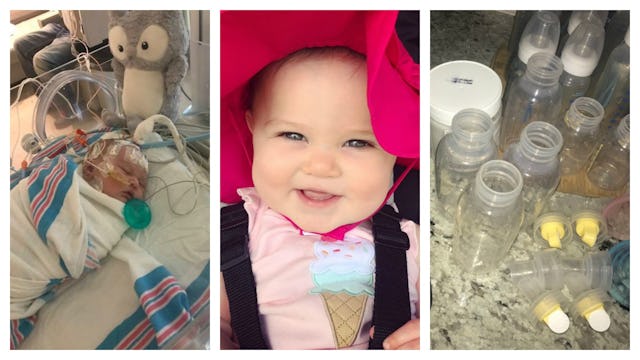I Pumped Over 10K Ounces. Here's What I Want Others To Know About Exclusively Pumping.

1,115 pumps, 10,500 ounces, over 738 hours.
That’s how long I spent attached to my breast pump. As a first-time mom with little knowledge about breastfeeding, I did as much research about the topic while I was pregnant. I was looking forward to starting this journey with my newborn and embracing what my body was meant to do—nourish my child.
When my Kennedy Sue was born, all seemed well. She latched right away, and seemed to take to nursing with ease. All of that changed when my daughter started seizing at 2 days old. After a stint in the PICU, my daughter was diagnosed with benign familial neonatal-infantile epilepsy at four days old. Thankfully, we live in Cleveland and had access to an unbelievable team of doctors who were able to get her on a dosage of medication to control her seizures right away.
Following her diagnosis, our breastfeeding journey changed. Her seizure medication made her drowsy, which meant every time she would latch on to nurse, the skin-to-skin contact would put her right to sleep. This, along with nipple confusion, caused us to switch to exclusively pumping (aka, EPing) at seven weeks old. This was something I wasn’t prepared for.
All of my research on breastfeeding never once mentioned that this could be a possibility. Breastfeeding was supposed to be easy, and natural—not like this. I was determined to provide breastmilk for my daughter in order to give her the very best, especially after her epilepsy diagnosis. While I mourned the loss of our nursing journey, I decided to fully embrace this new chapter of our breastfeeding journey.
Thanks to the support of my wonderful husband and family, and an exclusive pumping Facebook a group, I dove into the world of EPing. This meant:
– Enduring countless nights and early morning sitting awake attached to my pump while everyone else in my house (including my baby) slept.
– Still getting up when daughter woke in the middle of the night, even if I had already been awake for an hour because I had to pump.
– Mimicking my daughter’s feeds, so pumping 7-8 times a day until week 14.
– Finding the right size flange, buying lots of trial and error pump parts, and seeming to take stock in coconut oil.
– Leaking every time my daughter cried, only to have to feed her from a bottle and wait to pump until after she was fed.
– Taking supplements like sunflower lecithin and fenugreek to increase milk production.
– Becoming “famous” for pumping while driving (thanks to my hands-free pumping bra and car adapter).
– Hand-washing bottles and pump parts constantly because we didn’t own a dishwasher.
– Shedding many, many tears over spilled milk. Yes, this is a real thing. I now understand the saying of crying over spilled milk. That’s liquid gold.
However, the end result was worth it. 10 months, 3,500 frozen ounces, and one happy, healthy-exclusively breastmilk-fed (and SEIZURE-FREE) baby girl later, my pumping/breastfeeding journey came to an end. Though my breastfeeding journey might be different than others’ experiences, I wouldn’t trade one single second of it.
I want other mamas to know that exclusively pumping is a very real option for those who are unable to nurse, but want to breastfeed. It is something that they don’t necessarily teach in classes or write about in books, but it is a very real option—and you can do it.
On June 21st, this “Mother Pumper” said peace-out to her pump—until next time.
This article was originally published on